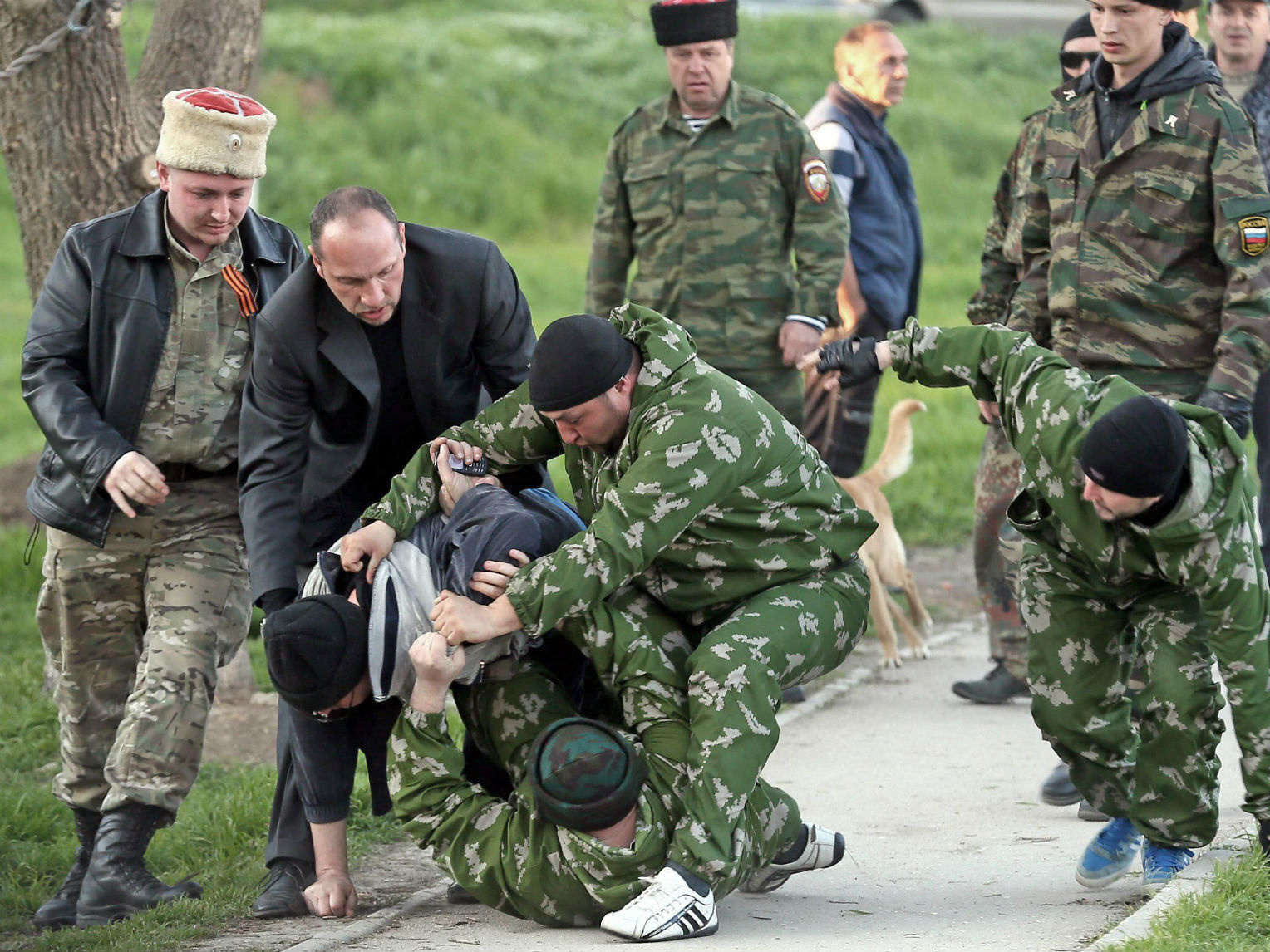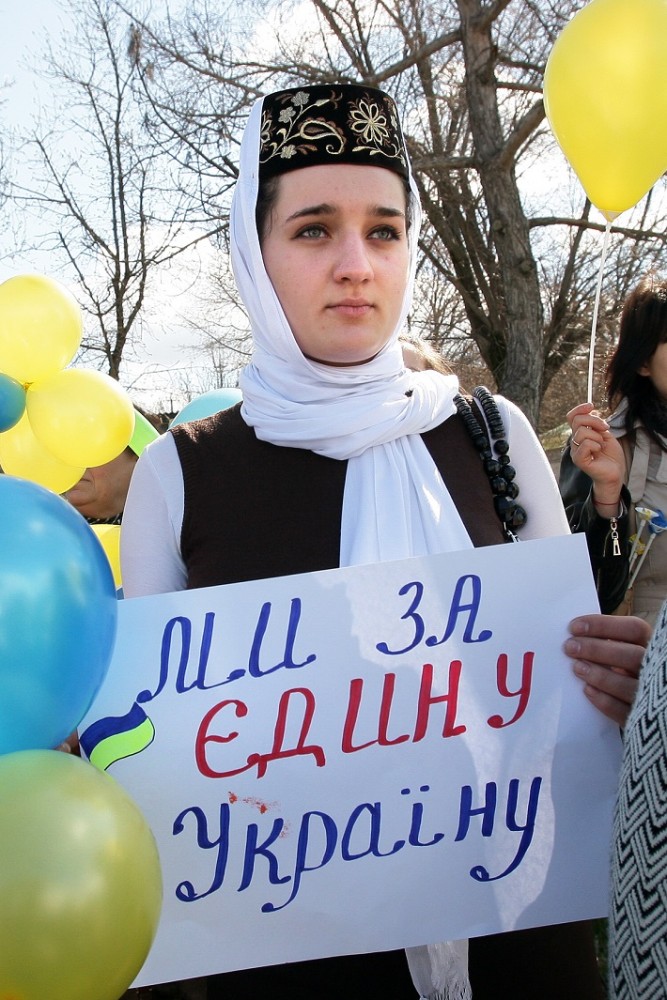On 16 March 2014, Russia established its illegal rule in Crimea by holding a so-called referendum. In the summer of 2013, the last summer before its occupation, the peninsula was one of the favorite resorts for Ukrainians. Four years after the illegal annexation, this tourist destination turned in a military base where human rights don’t mean anything.
Crimean Tatar leader Mustafa Dzhemilev, referring to Ukrainian intelligence, told Ukrainian media that nowadays there are 70,000 Russian soldiers and members of special operations forces in Crimea. This is about 3 times more servicemen than stationed by Ukraine before the occupation. Crimea now has 18 military bases. As well, the Russians are recreating the old Soviet military infrastructure.
Conflicts between soldiers and locals
In late 2017, a significant conflict between the locals and the members of the military units took place. It started when locals of the Zolotoie village started opposing military men who tried to establish a radar system near private land plots.
The locals said they were not shown any permits for the construction or establishment of the radar system. However, the works started anyway. Trying to prevent it, people laid down in front of the military trucks. One woman felt ill and needed the help of an ambulance. A man stood in the concrete pit, attempting to stop the construction. The constructors carried on, emptying buckets of concrete into the pit. Eventually, the man needed an ambulance as well.
After the incident, the protesters filed a complaint with the so-called Prosecutor’s Office of Crimea asking to protect them. However, it’s unlikely that any action will be taken.
In July 2017, the Main Intelligence Department of the Ministry of Defense of Ukraine pointed to another similar incident with the involvement of Russian soldiers. Near the town of Lybimivka, Russian occupation forces have been expanding the military campus of the radio engineering regiment – at the expense of the land and houses of the locals.
In response to numerous citizen complaints regarding the illegal actions of the Russian military, representatives of the occupation authorities and “law enforcement agencies” claimed that the locals had registered their property illegally.
The weapons
Living side by side with soldiers became an ordinary thing for Crimeans. Military trainings on the peninsula happen almost every month.
For example, during one near Sevastopol in January 2018, the marches were accompanied by the deployment of the second division of “Triumph” Russian anti-aircraft missile system S-400. The Russian military command explained that the system will control the sky near the administrative border between occupied Crimea and mainland Ukraine.
The first division of S-400 was deployed to Crimea at the beginning of 2017 near the city of Feodosia.
S-400 “Triumf” is a Russian large and mmedium-range anti-aircraft missile system. The system is said to be able to hit aerodynamic targets at a distance of up to 400 km, which is enough to reach the territory of Türkiye, and ballistic targets up to 60 km.
Another notable weapon on the peninsula is self-propelled anti-aircraft rocket-gun complex Pantsir-S.

Pantsir-S has been used in Syria. The Russian state media Russia Today wrote that in Syria it won fame as the most effective measure to counter attacks of UAVs.
“The lack of such complex in the US forces is a significant disadvantage of the American antiaircraft defense,” wrote RT.
Its main technical feature are its anti-aircraft guns (30-mm submachine guns 2A38M), missile armament (installation 57E6E):
“Along with the Tor-M2 anti-aircraft missile system, Pantsir is the only air defense system capable of firing at targets which move.”

These and other weapons were presented to Crimeans on 23 of February, which is marked as a holiday called Defender of the Fatherland Day in Russia.
Ihor Romanenko, a military expert and deputy head of the General Staff of the Ukrainian Armed Forces, is confident that the anti-aircraft missile systems themselves are not dangerous to Ukraine, as their purpose is to destroy air targets. According to him, the anti-aircraft missile systems on the peninsula are first of all aimed at NATO countries, despite Russian media reporting that they are aimed at eliminating threats coming from Ukraine.
Yuriy Kostiuchenko, an expert on safety and risk issues told RFE/RL that the deployment of such weapons is a part of Russia’s “State program on armament for 2007-2015” and the “Program of the reform of Armed forces of Russia for 2008-2020”:
“All this happens in terms of the common foreign policy direction defined by Putin’s ‘Munich speech’ on 10 February 2007 during the Conference on security, and in terms of the Military Doctrine of Russia in the edition of 25 December 2014. It is according to these documents that NATO and Ukraine are defined as the main threats to Russia’s security.”
However, a NATO security programs expert and analyst of the American-German Marshall Fund Bruno Lete says that the systems do pose threats:
“The S-400 complex can intercept absolutely anything in the sky – jets, tactical missiles… We see that Russia is turning Crimea into a peninsula which projects force not only on Ukraine, but the whole Black Sea region. Russia’s nuclear rockets are capable of reaching any point on the planet,” he said.
Nuclear weapons
Meanwhile, some Ukrainian experts state that Russia has already transferred nuclear weapons to Crimea. Mustafa Dzhemilev told a Ukrainian channel that he has confirmation from two not unconnected sources that Russia has placed 6 nuclear warheads in Crimea.
Earlier, the speaker of the General Staff of the Armed Forces of Ukraine Vladyslav Seleznyov confirmed that premises where nuclear weapons can be kept exist near Feodosiya.
However, the Ukrainian military can’t directly confirm they are really kept there. But it is likely, as during the Kavkaz-2016 military trainings Russian soldiers practiced to transport and deploy nuclear weapons.
“Taking into account me personal experience of using these tactical nuclear weapons, I want to say: they have them, they used them during the trainings,” Romanenko said in February 2017.
“When we talk about nuclear weapons, usually we imagine large intercontinental missiles – strategic weapons. However, we know that Russia develops nuclear weapons of small sizes, which is also unacceptable,” says Lete.
The head of the mission of Ukraine at NATO Vadym Prystayko also confirms that infrastructure which is able to support nuclear weapons is being recreated in Crimea, however, there is no confirmation of their presence yet.
NATO and Russia
NATO expresses its concerns due to the peninsula’s growing militarization:
“We condemn this and express serious concerns over Russia’s further expansion of its military presence in the Black Sea region,” said Deputy Director of NATO Liaison Office in Ukraine Ann-Kristin Bjergene.
In its turn, Russia blames NATO for the situation in Ukraine:
“The Ukrainian crisis wasn’t the reason of the current relations between Russia and the West, it was more a result of the policies which western countries, first of all the US and NATO countries, conducted after the end of the Cold War. Instead of using the unique historical chance to form a truly pan-European structure of security and cooperation, the West chose to expand NATO in spite of all the promises which heads of the US and many European countries gave in 1990 – that the Alliance will not advance one inch to the East,” said Russia’s Foreign Policy Minister Sergey Lavrov in the interview to a Serb media BETA. He added that what has happened in Ukraine became a result of the direction chosen by NATO.
Replacing Ukrainians and Crimean Tatars
Meanwhile, human rights defenders sound their own alarms. According to the population census conducted by Russia in 2014, the amount of Ukrainians on the peninsula dropped from 26% to 15%, and Crimean Tatars from 13% to 10%.
Ukraine’s First Deputy Minister of Information Policy Emine Dzhepparova emphasized that the replacement of the civilian population during occupation is a war crime which violates the Geneva Convention.
She also added that officially there are about 27,000 registered IDPs from Crimea. But the unofficial number is about 60,000. According to Dzhepparova, this is explained by many IDPs not wanting to be marked as IDPs because they consider themselves citizens of Ukraine.
For Mustafa Dzhemilev, this is a tragedy. He was one of the activists who succeeded in returning the Crimean Tatars from exile in Central Asia, where they had been deported by Stalin, back to their homeland.
“For a half of a century, we were fighting to return those who stayed alive to the fatherland. And now we have new occupation and new history, and again the repetition of the policy of forced deportation, forcing local citizens to leave their territories and replacing them with citizens of the Russian Federation on the occupied territories. The exact data are carefully hidden, however, we have some information. For example, according to media of the occupied Crimea, during the 3.5 years of the occupation, the population of Crimea increased by 10%,” Dzhemilev told in December 2017.
He also pointed out that during this period, mortality in Crimea increased nearly by 1.7 times, and morbidity doubled.
Also, Crimeans started to be recruited to the Russian military services, which is again a violation of the Geneva convention. Russia included Crimea in its Southern Military District. Overall, 2,400 Crimeans were conscripted to the Russian Army during the last autumn call. 600 out of them will serve outside of Crimea.
Read more:
- New UN resolution on Crimea confirms Russia is an occupying power
- Three years later, Crimea abandoned by both Ukraine and Russia
- Don’t forget those kidnapped in occupied Crimea
- Fixing mistakes. How Ukraine treats Crimean Tatars after the occupation of Crimea
- Human rights violations in Crimea to be investigated as war crimes







